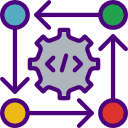Low-code and no-code development platforms have revolutionized the way businesses build and deploy applications. By reducing the need for traditional coding skills, these tools enable professionals from diverse backgrounds to automate workflows, design apps, and foster innovation. In this comprehensive overview, we examine the standout features, usability, integration capabilities, and pricing models of today’s most popular low-code/no-code tools to help you make an informed decision for your organization’s needs.
Key Features and Capabilities

Power Automate
Power Automate by Microsoft specializes in creating automated workflows between numerous apps and services. Its intuitive drag-and-drop interface allows users to automate repetitive tasks, synchronize files, and collect data without writing any code. The platform delivers powerful connectors for Microsoft 365, Dynamics, and many external services, giving businesses flexibility and control over process automation. Security and compliance features within Power Automate make it especially suitable for enterprise environments where data governance is critical, and built-in analytics help monitor automation effectiveness in real time.

OutSystems
OutSystems is renowned for balancing rapid development with high scalability. Its platform provides visual app design tools alongside advanced options for integration with legacy systems and custom code when needed. Rich templates, reusable components, and built-in mobile responsiveness allow for quick prototyping and deployment across devices. OutSystems also emphasizes lifecycle management, offering robust tools for app updates, version control, testing, and monitoring, making it a reliable choice for organizations needing comprehensive development capabilities without sacrificing agility.

Appgyver
Appgyver stands out by delivering truly no-code development without sacrificing complexity or functionality. Users can construct sophisticated web and mobile applications purely through a visual builder. Integration with REST APIs, data sources, and a component marketplace add significant value, enabling customization beyond the basics. Appgyver’s flexibility appeals to startups and enterprises alike, providing everything from prototyping tools to advanced business logic and cloud deployment, all with a focus on empowering non-developers to bring their ideas to life quickly.
Ease of Use and Learning Curve
Mendix
Mendix is designed with a “citizen developer” mindset, offering a straightforward environment that lowers the entry barrier for building apps. Its guided tutorials, community-driven forums, and well-documented knowledge base make it easy for users to acquire foundational skills and advance toward more complex tasks. The platform’s visual interface allows for drag-and-drop assembling of business logic and UI components, while power users can delve into Java actions for customized features. This blended approach supports both beginners and professionals in reaching their goals efficiently.
Bubble
Bubble is synonymous with full-stack no-code development and appeals to users seeking a gentle onboarding process. The platform guides new users through interactive lessons, walkthroughs, and a rich directory of plug-ins. Bubble’s drag-and-drop builder, complemented by robust “workflows” for logic creation, makes app development approachable and engaging. While the initial learning curve is shallow for basic apps, Bubble thoughtfully scales in complexity, ensuring that as users’ ambitions grow, the platform can meet their increasingly sophisticated project requirements.
Quick Base
Quick Base emphasizes immediate usability by offering prebuilt templates, dynamic forms, and an intuitive UI. Training materials, videos, and an active customer community further reduce the ramp-up time for users new to application development. With its focus on streamlining everyday processes, Quick Base helps business users translate their knowledge into automated workflows and custom applications. Its platform is particularly suited for organizations aiming to empower non-technical staff with DIY app creation while still enabling IT oversight and governance.
Salesforce Lightning Platform
Salesforce Lightning Platform is renowned for its deep integration with the Salesforce ecosystem and third-party applications. Users can automate business processes across sales, service, and marketing, bringing together disparate datasets in one unified environment. The platform supports robust APIs and extensive AppExchange plug-ins, ensuring developers can extend functionality or tie in custom logic as needed. Enterprises benefit from the framework’s scalability and tight security controls, making it a popular choice for organizations entrenched in the Salesforce ecosystem.
Zoho Creator
Zoho Creator provides extensive integration capabilities, supporting a broad array of third-party applications and popular services through inbuilt connectors. Its workflow automation features enable users to create complex logic that interacts with email, cloud storage, CRM systems, and more. Through REST APIs and webhook support, Zoho Creator empowers developers to connect custom data sources and build highly tailored solutions. Businesses that operate in multi-vendor environments or with distributed teams find Zoho Creator particularly adept at breaking down data silos.
Betty Blocks
Betty Blocks distinguishes itself with a strong focus on open integration standards and API accessibility. The platform’s no-code environment allows users to orchestrate workflows that span various external services, databases, and even custom-built applications. With reusable “blocks” and connectors, organizations can easily extend the platform as their needs change. Betty Blocks also supports embedding applications into existing enterprise environments, reducing the friction often associated with software adoption and fostering business agility.
Join our mailing list
